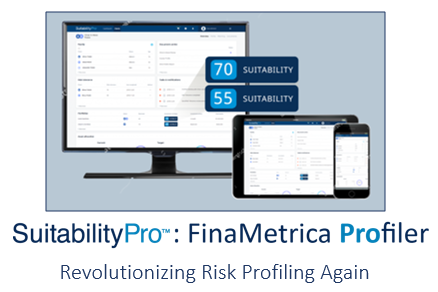FinaMetrica - Wednesday, 20 March 2019
FinaMetrica, part of PlanPlus Global, has developed a new fund mapping 'Suitability Seal' to help financial advisors evidence, with confidence, that the investment portfolios they recommend are appropriate in terms of their clients' risk tolerance and specific needs and circumstances.
In the fund management industry, the mapping of portfolios to risk bands has almost always involved matching a risk tolerance score to a determined range of equity exposure in any given portfolio. When conducted correctly, through a psychometric test, an individual's risk tolerance measures their willingness to take on risk in line with their personality traits. When tolerance is conducted incorrectly, through an unscientific and unproven method, the resulting mapping is effectively meaningless, indefensible and dangerous. A reliable risk tolerance assessment is the foundation of suitable investment advice.
However, as Paul Resnik, Executive Director of PlanPlus Global has said: "Risk tolerance should not be the only indication of the suitability of a portfolio recommendation. We now have the ability, through technology, to be more scientific and accurate in our measurements. Risk profiling processes are always evolving, always improving. That's what we should all be striving for in the financial services profession."
That's why we are pleased to announce that SuitabilityProTM mapping will take into account an investor's risk tolerance and their risk capacity - which considers time-horizon, behaviour and emotional composure at the time of the risk profile assessment, as well as the investor's experience. This new and improved approach highlights an investor's willingness to take on risk and, importantly, their ability to do so. This is a significant evolution in the practice of fund mapping that raises the suitability bar considerably.
.png.aspx)
"An individual's capacity to take investment risk has the potential to impact their overall risk profile. Sometimes that impact can be considerable. That's why it is vital to properly assess both willingness and ability before mapping to any portfolio. In doing so, FinaMetrica has developed the industry's first 'suitability' fund mapping process", says Shawn Brayman, CEO, PlanPlus Global.
"Advisors should regularly reassess their client's overall risk profile to ensure the portfolios recommended remain suitable. While risk tolerance does not change significantly over time, people's behaviours and their capacity to withstand losses do change, especially as time horizons shorten. Through the FinaMetrica process, advisors can easily demonstrate the value of their ongoing service fees."
FinaMetrica subscribers can now be reassured that whenever they see a FinaMetrica fund mapping 'Suitability Seal', their portfolio recommendation has been assessed at the highest possible risk-profiling level.
What is the Suitability Seal?
A wide range of fund providers retain PlanPlus Global/FinaMetrica to review their portfolio solutions to determine the appropriate level of growth assets to apply for each solution. For each level of growth assets (0% to 100%), there is an associated range of scores where the solution would be suitable for clients. The results are provided in a table form as shown below.
.png.aspx)
The Suitability Seal is an easily-understood visual representation of the OK Risk score range.
.png.aspx) Why is there a range for a fund?
Why is there a range for a fund?
In a well-constructed portfolio, a client who is comfortable with 45% growth assets, will also be comfortable with 46% or 44%; 47% or 43%; and so on. Hence, we show a comfort range, as well as marginal ranges between comfort and discomfort on both the upside and the downside.
How do you determine the range for a fund?
The full methodology is documented in our
Asset Allocation Mappings Guide, in simple terms, we evaluated the responses of hundreds of thousands of people who have completed the FinaMetrica risk tolerance assessment. This enabled us to determine the amount of growth assets investors "prefer" to have for various levels of risk tolerance. This data was then used to determine a relationship between score and the level of growth exposure preferred.
How do I determine the score for my client that maps into these funds?
You start with the most researched and validated psychometric risk tolerance assessment in the world, from FinaMetrica. This will produce a score between 0 and 100, unique to each client. Advisors then need to consider other factors, such as capacity for loss, time horizon, previous investing experience and other influences to determine if they need to adjust this tolerance number to arrive at a more holistic score (sometimes called Attitude to Risk or Risk Profile). If these other considerations are not limitations for the client; then the Risk Tolerance number is the same as the Profile.
The new SuitabilityPro
TM: FinaMetrica
Profiler offers a more formalized methodology to support advisors in how to apply their professional judgement by further determination of factors such as a client's capacity for loss. The resulting "Suitability Score" combines all the factors an advisor must weigh in making their recommendations.
Can a client have more than one number or map to more than one portfolio?
Every client has one "tolerance", in the same way we each have one IQ or one body temperature. However, while some clients want to manage all of their money in one "bucket" or portfolio to fund all of their goals; others may create "multiple buckets" that are intended to finance different goals, for example, a portfolio for retirement and a different one for their children's education. In that case, each portfolio can have a different time horizon, capacity for loss and be of different levels of importance to the client. The result would be a different suitability score for the portfolio associated with each separate goal.
This introduction of the industry's first fund mapping 'Suitability Seal' follows our recent announcement of our upcoming launch of SuitabilityPro
TM, the world's first end-to-end connected suitability process, which combines FinaMetrica's world-leading psychometric risk profiling solution with multi-lingual, multi-currency, multi-country, and multi-award-winning financial planning software, along with a new portfolio monitoring tool that continuously ensures advisors' clients remain suitably invested over time.

Posted:
20/03/2019 12:00:00 AM by
FinaMetrica | with
0 comments